Radio communication is an integral part of nautical life. Whether you are a casual boater or a seagoing professional, this article provides the marine channels you need for programming modern VHF-UHF radios with the international frequencies for ships, yachts, motorboats, ferries, sailboats, cruise ships, freighters, tankers, industrial docks, skiffs, riverboats, inflatables, aquatic sports, fishing, kayaks, and all types of watercraft. Program your walkie talkies with this free programming list. For Baofeng or any other type of radio, these are the communication frequencies for oceans, seas, lakes, and rivers of the…
The original source of this article is RadioMaster Reports.
International Marine VHF and UHF Channel Frequencies Programming
PRINT THIS Marine VHF UHF channel list and save it. You will need it later.
PRINT THIS Marine VHF UHF channel list and save it.
Download: Marine VHF UHF Channels for Chirp Programming
- You will need a USB-to-Radio programming cable that is made for use with your radio. One end plugs into the USB port of your computer and the other plugs into the microphone jack of your radio.
- Program your radio with free Chirp software.

- Use the programming list to build your channel list into Chirp.
- Upload the file to your radio.
- Check your radio for proper operation.
Typical USB to Radio Programming Cables:
Backup Radios for Marine Use
Accidents happen on the water, just like they do on land. All ships and boats should have a proper VHF marine radio and keep it tuned to Channel 16 for normal safety and distress calls. The cost of a bonafide Marine VHF radio is not high. But, mariners also like to keep a backup radio on hand for when the main radio goes out or the marine VHF walkie talkie gets lost. Also, there is a need for UHF among some users, especially for operation with cruise ships and industrial operations. Larger ships, and especially petroleum industry vessels issue intrinsically safe radios to their crews. These are sealed to prevent any internal sparks from igniting fuel on board or at port. UHF capability is a feature that is not often found in lower priced marine VHF HTs. Ship crews often use separate UHF-only radios for on board comms. Fortunately, modern VHF-UHF walkie talkie HT handheld transceivers are inexpensive (in the $25 range) and ubiquitous. With the programming list provided here, they have all the channels and communication capability of a marine VHF HT plus a UHF HT. Such inexpensive radios can easily be acquired online or even in the local radio electronics shops of ports all over the world. These days, all crew members can easily afford their own personal radio, and now they never need to be without a backup radio of their own. Add a longer whip antenna (in the $12 range) on them and the VHF distance performance can be quite good for intership or ship-to-shore.
Sure, many of the cheaper radios are not waterproof, rugged, or intrinsically safe; and they certainly aren’t maritime-rated or type accepted for marine service, but they will still communicate adequately. The audio quality is usually good enough that the party on the other end of the transmission won’t even suspect what type of radio you are on. Keep it in a sealed zip lock plastic bag or water sports radio bag and it should provide many years of backup service. The radio might even save the life of you and your shipmates some day.
Distress Safety and Calling Channels
There are 3 VHF channels recognized worldwide for marine safety purposes:
MAR 16 (156.800 MHz) – Distress, Safety and Calling
MAR 13 (156.650 MHz) – Intership Navigation, Bridge-to-Bridge
MAR 70 (156.525 MHz) – Digital Selective Calling
The channels should be set to scan channels 16 and 13.
UHF Cruise Ship Frequencies On Board
UHF frequencies are part of the channel list. These are not VHF marine channels, but they are the UHF marine channels commonly utilized on board large vessels, such as cruise ships and ferries. Ships also may have UHF repeaters on these frequencies for use by the working crews. There are 6 sets of paired channels. The 457 MHz range is common to both european CEPT and USA/North American ships. The channels in the 467 MHz range may vary by the area where the vessel is from. The UHF channel names with A designators are european CEPT and the channel names with B designators are USA/North American. Example: Channel UHF1B is a USA/North America channel at 467.750000 MHz. The repeater offset is 10.000000 MHz for CEPT vessels and 10.225000 MHz for USA and North American vessels. Duplex UHF repeaters with either (-) Negative or (+) Positive splits are common on vessels.
Most on board UHF ship radios utilize PL or CTCSS sub-audible tone squelch, although some use DCS digital coded squelch. The most common PL tone (88.5 Hz) is provided as a default in the programming list, but you may need to manually change the programming of that default tone on a channel to another specific tone frequency, to be compatible with a specific ship channel. The programming list uses carrier squelch for receive, so you can always listen to all transmissions by ships on the UHF channels, but they probably will not hear your transmission unless you change the PL transmit tone to the same tone as they are using. These same UHF channels are also found around major shipyards, freight docks, freighters, tankers, industrial marine sites, oil platforms, ports, and many other types of marine sites.

Cruise ship passengers commonly use FRS or PMR radios to keep in touch with family members on the cruise
Additional Walkie Talkie Channels
A few additional walkie talkie channels are provided in the programming list. These include FRS, PMR, FreeNet, MURS, etc. They may come in handy to communicate with common bubble pack radios or other non-marine HT radios that are often encountered around marine environments. It is very common for passengers on cruise ships to use PMR Personal Mobile Radio or FRS Family Radio Service radios while on board, on shore tours, and in ports.
New Marine VHF Channels 12.5 kHz Interleaved
New maritime VHF channels which are interleaved between the existing channels are now available for use by suitably equipped vessels in some areas of the world. These new channels are numbered in the 200 series, and they are spaced at 12.5 kHz intervals from the previous channel frequencies. The use of these channels is in addition to the existing channels, and they do not replace the existing channels. Channel 16 calling, distress and safety channel remains the same, and the interleaved channels adjacent to it are reserved and not utilized in the interleaving plan, to prevent interference. Additionally, new AIS automatic identification system vessel tracking channels have been added, and new AIS services are being expanded in some areas. As part of the spectrum efficiency process called narrowbanding, the international maritime VHF band will also be further interleaved with 6.25 kHz spaced channels in the near future. More digital services and digitized voice modes will be applied to these channels. The narrowband 6.25 kHz marine VHF channels will have channel numbers in the 1000 series.
Marine VHF UHF Channel Frequencies USA-Canada Programming List 2016B
| MEM | CHANNEL NAME | FREQUENCY | TRANSMIT |
| 0 | MAR01 | 160.650000 | -4.6MHz |
| 1 | MAR01A | 156.050000 | SIMPLEX |
| 2 | MAR02 | 160.700000 | -4.6MHz |
| 3 | MAR02A | 156.100000 | SIMPLEX |
| 4 | MAR03A | 156.150000 | SIMPLEX |
| 5 | MAR04A | 156.200000 | SIMPLEX |
| 6 | MAR05A | 156.250000 | SIMPLEX |
| 7 | MAR06 | 156.300000 | SIMPLEX |
| 8 | MAR07A | 156.350000 | SIMPLEX |
| 9 | MAR08 | 156.400000 | SIMPLEX |
| 10 | MAR09 | 156.450000 | SIMPLEX |
| 11 | MAR10 | 156.500000 | SIMPLEX |
| 12 | MAR11 | 156.550000 | SIMPLEX |
| 13 | MAR12 | 156.600000 | SIMPLEX |
| 14 | MAR13 | 156.650000 | SIMPLEX |
| 15 | MAR14 | 156.700000 | SIMPLEX |
| 16 | MAR 16 | 156.800000 | SIMPLEX |
| 17 | MAR15 | 156.750000 | SIMPLEX |
| 18 | MAR17 | 156.850000 | SIMPLEX |
| 19 | MAR18A | 156.900000 | SIMPLEX |
| 20 | MAR19A | 156.950000 | SIMPLEX |
| 21 | MAR20 | 161.600000 | -4.6MHz |
| 22 | MAR20A | 157.000000 | SIMPLEX |
| 23 | MAR21 | 161.650000 | -4.6MHz |
| 24 | MAR21A | 157.050000 | SIMPLEX |
| 25 | MAR22A | 157.100000 | SIMPLEX |
| 26 | MAR23 | 161.750000 | -4.6MHz |
| 27 | MAR23A | 157.150000 | SIMPLEX |
| 28 | MAR24 | 161.800000 | -4.6MHz |
| 29 | MAR25 | 161.850000 | -4.6MHz |
| 30 | MAR26 | 161.900000 | -4.6MHz |
| 31 | MAR27 | 161.950000 | -4.6MHz |
| 32 | MAR28 | 162.000000 | -4.6MHz |
| 33 | MAR60 | 160.625000 | -4.6MHz |
| 34 | MAR60A | 156.025000 | SIMPLEX |
| 35 | MAR61A | 156.075000 | SIMPLEX |
| 36 | MAR62A | 156.125000 | SIMPLEX |
| 37 | MAR63A | 156.175000 | SIMPLEX |
| 38 | MAR64A | 156.225000 | SIMPLEX |
| 39 | MAR65A | 156.275000 | SIMPLEX |
| 40 | MAR66A | 156.325000 | SIMPLEX |
| 41 | MAR67 | 156.375000 | SIMPLEX |
| 42 | MAR68 | 156.425000 | SIMPLEX |
| 43 | MAR69 | 156.475000 | SIMPLEX |
| 44 | MAR70 | 156.525000 | SIMPLEX |
| 45 | MAR71 | 156.575000 | SIMPLEX |
| 46 | MAR72 | 156.625000 | SIMPLEX |
| 47 | MAR73 | 156.675000 | SIMPLEX |
| 48 | MAR74 | 156.725000 | SIMPLEX |
| 49 | MAR75 | 156.775000 | SIMPLEX |
| 50 | MAR76 | 156.825000 | SIMPLEX |
| 51 | MAR77 | 156.875000 | SIMPLEX |
| 52 | MAR78A | 156.925000 | SIMPLEX |
| 53 | MAR79A | 156.975000 | SIMPLEX |
| 54 | MAR80A | 157.025000 | SIMPLEX |
| 55 | MAR81A | 157.075000 | SIMPLEX |
| 56 | MAR82A | 157.125000 | SIMPLEX |
| 57 | MAR83 | 161.775000 | -4.6MHz |
| 58 | MAR83A | 157.175000 | SIMPLEX |
| 59 | MAR84 | 161.825000 | -4.6MHz |
| 60 | MAR84A | 157.225000 | SIMPLEX |
| 61 | MAR85 | 161.875000 | -4.6MHz |
| 62 | MAR85A | 157.275000 | SIMPLEX |
| 63 | MAR86 | 161.925000 | -4.6MHz |
| 64 | MAR86A | 157.325000 | SIMPLEX |
| 65 | MAR87 | 161.975000 | -4.6MHz |
| 66 | MAR87A | 157.375000 | SIMPLEX |
| 67 | MAR88 | 162.025000 | -4.6MHz |
| 68 | MAR88A | 157.425000 | SIMPLEX |
| 69 | WX 1 | 162.550000 | off |
| 70 | WX 2 | 162.400000 | off |
| 71 | WX 3 | 162.475000 | off |
| 72 | WX 4 | 162.425000 | off |
| 73 | WX 5 | 162.450000 | off |
| 74 | WX 6 | 162.500000 | off |
| 75 | WX 7 | 162.525000 | off |
| 76 | UHF 1 | 467.525000 | SIMPLEX |
| 77 | UHF 1A | 457.525000 | SIMPLEX |
| 78 | UHF 1B | 467.750000 | SIMPLEX |
| 79 | UHF 2 | 467.550000 | SIMPLEX |
| 80 | UHF 2A | 457.550000 | SIMPLEX |
| 81 | UHF 2B | 467.775000 | SIMPLEX |
| 82 | UHF 3 | 467.575000 | SIMPLEX |
| 83 | UHF 3A | 457.575000 | SIMPLEX |
| 84 | UHF 3B | 467.800000 | SIMPLEX |
| 85 | UHF 4 | 467.500000 | SIMPLEX |
| 86 | UHF 4A | 457.500000 | SIMPLEX |
| 87 | UHF 4B | 467.725000 | SIMPLEX |
| 88 | UHF 5 | 467.600000 | SIMPLEX |
| 89 | UHF 5A | 457.600000 | SIMPLEX |
| 90 | UHF 5B | 467.825000 | SIMPLEX |
| 91 | UHF 6 | 467.625000 | SIMPLEX |
| 92 | UHF 6A | 457.625000 | SIMPLEX |
| 93 | UHF 6B | 467.850000 | SIMPLEX |
| 94 | FRS 1 | 462.562500 | SIMPLEX |
| 95 | FRS 3 | 462.612500 | SIMPLEX |
| 96 | PMR 3 | 446.031250 | SIMPLEX |
| 97 | MURS 1 | 151.820000 | SIMPLEX |
| 98 | MURS 2 | 151.880000 | SIMPLEX |
| 99 | MURS 3 | 151.940000 | SIMPLEX |
International Standard Channel Frequency List for Maritime Mobile UHF: ITU-R M.1174-3

ITU-R M.1174-3 UHF MARINE channels (release date 2015) international standard list of UHF marine frequencies for use on vessels. This chart includes the original 6 channels (mostly analog FM at 25 kHz channel spacing). The 25 splinter channels (analog or digital at 12.5 kHz channel spacing). The new narrowband digital channel numbers 102-161 and 202-261 are interspersed (at 6.25 kHz channel spacing) between the splinter channels. The international standard for split frequency duplex is for base or repeater on the Lower Channel, but some vessels utilize the opposite of this standard.
The following chart shows the Lower Band and Upper Band paired UHF marine onboard channels for repeaters.
Submission of monitoring reports, imagery, errata, and detailed information is encouraged by RadioMaster Reports.

Disclaimer: Content provided in RadioMaster Reports is included for the sole purpose of providing educational information on a passive basis. This information may be useful to the public in the event of emergencies. Users of this educational information are solely responsible for their actions.
©2016 RadioMaster Reports
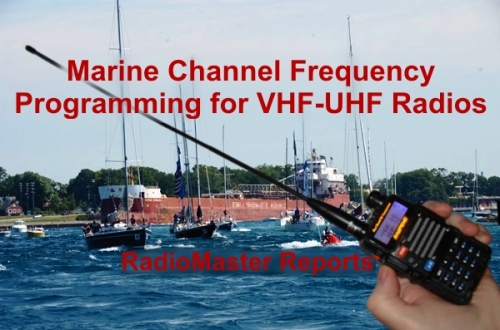

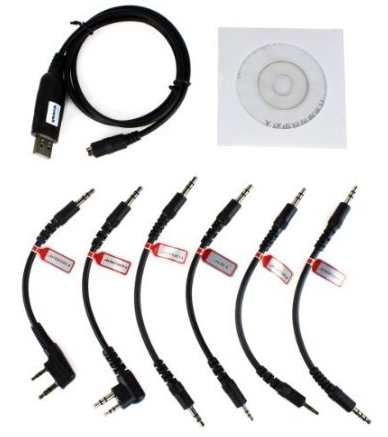
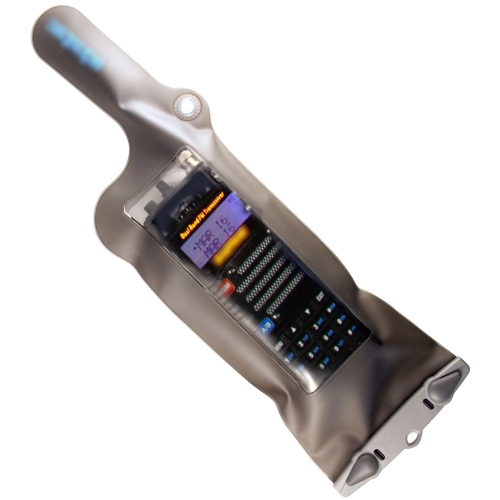

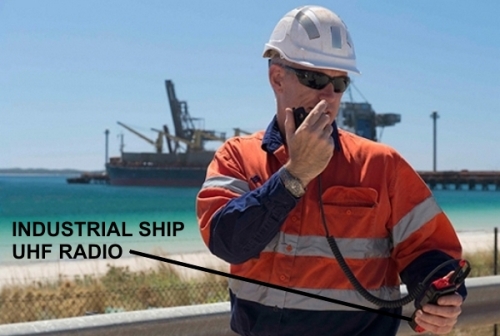

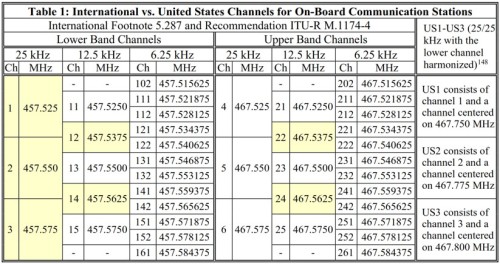


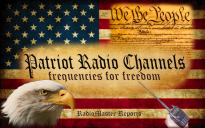

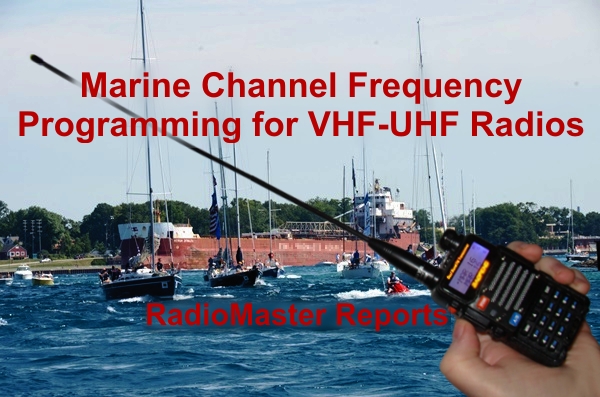

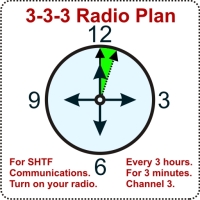

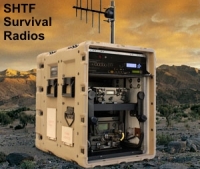




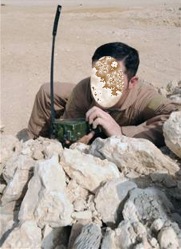




Hi. I have a pair of these radios and I am trying to get a PTT to work with them with no luck at all. The system I am using is an eBay special, military style headset with the oversized 4 way plug and a PTT button with a 2.5m plug for the radio end. The speaker works fine but the PTT either doesn’t work at all or will activate the mic for a second and then it shuts off. Any tips would be appreciated, I am having a real hard time finding anything useful (read very ammature level) for this.
thank you for inform us. I feel happy to know industrial Communicative operation of radio. for a long times i would attempted to create frequency programming and make free channel conditionally same communication operation Icom and pptf were can’t resistant water proof and crash accident. so i need metal cover absolutely strength frequency channel file.
Hey thankya for the channel download it helps to have a spare radio for going ashore. The frs channels in it turned out to be real handy too. We can talk to those talkabouts the kids have
Thank you for the file! I was going to start typing every channel in by hand before coming across this post. It saved me quite a bit of time!
Thanks for this article, saves me a lot of research. And the printable image is very handy indeed!
why ch 9 is 156.400 instead of 156.450 usa canada marine ch list wrong i guess
The list is correct. You appear to be confusing the memory position number with the channel number (channel name). MAR09 is 156.450 MHz. Be sure to use Channel Name for your display.
Hi,
can you mail me the 70cm list for chirp?
Thank you
respectfully, no.
The links to the frenquency files does not work anymore
Yes, the CSV link is dead, does anyone have a mirror please?
Love this pst, great read! The links for the frequency files did not open for me either, anyone still have them? Petra506468@gmail.com
file not found on csv files
files should work on uv-9r if i can source them (i hope)
for international .
save me ton of work
I agree with you
Hey everyone. Here’s a working link to a CSV for International Marine Channels.
https://www.dropbox.com/s/kl5khd4zkc3ft0j/MARINE_VHF_UHF_INTERNATIONAL_2016B.csv?dl=0
Thanx for this listing I was able to get it programmed and working as backup for my boat
joseantordz1412@gmail.com
Quiero saber las frecuencias del estado donde vivo en Tamaulipas Matamoros q son de emergencia tengo radios Baofeng porfa saludos gracias